In this article
This guide is your definitive resource for navigating the complex world of women’s hiking boots. We’ll move beyond marketing jargon to provide an expert-level framework that ensures your boots become a trusted partner and outdoor companion for every adventure. We’ll start by deconstructing the anatomy of a world-class hiking boot, then guide you through the non-negotiable rules for achieving a flawless, blister-free fit. From there, you’ll get specific, trail-tested recommendations to match the perfect pair to your hiking style and budget, and finally, learn how to properly break-in, clean, and maintain your investment for years of reliable service on the trail.
The Anatomy of a World-Class Hiking Boot
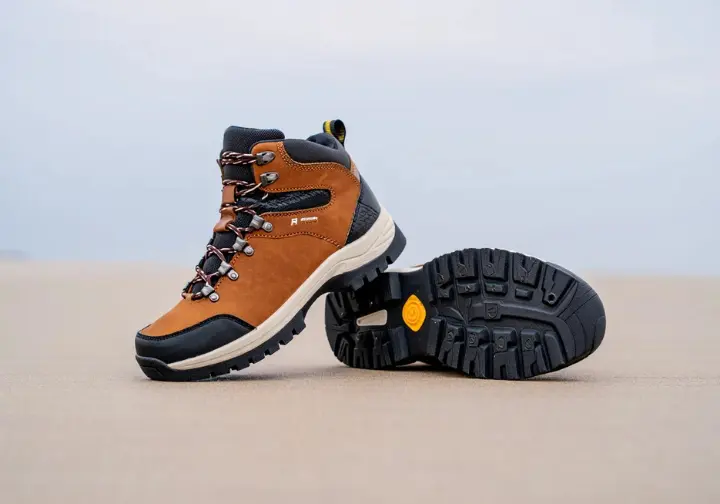
To make an informed choice, you must first understand the architecture of a hiking boot. A deeper knowledge of its components and materials is what separates a savvy hiker from a casual buyer. This section deconstructs the key elements that define a boot’s performance, durability, and comfort on any hiking trail.
Beyond the Laces: Deconstructing the Modern Boot
A hiking boot is far more than meets the eye. The main body, or upper, acts as the protective shell, shielding your foot from weather and trail hazards. This is reinforced by the boot’s armor: a rubber toe cap protects from impacts, while a rand guards the junction between the upper and midsole from abrasion. Beneath this lies the engine room, where the midsole provides cushioning and shock absorption. Within this layer, a semi-rigid shank adds stiffness to support your arch under a heavy pack, a feature crucial for good ankle support. The outsole is the rubber layer making contact with the trail, with its lug pattern dictating traction. Finally, the comfort system—the tongue, collar, and lacing—works to secure your foot. Knowing these parts is the first step to avoid common foot problems from ill-fitting footwear and making a smart purchase.
The Materials Matrix: Leather vs. Synthetics
The upper’s material is a primary driver of a boot’s character. Full-grain leather is the hallmark of traditional hiking boots, prized for durability on rugged treks, but it’s heavy and requires a long break-in period. Nubuck and suede leathers offer a popular middle ground, balancing flexibility and durability. Synthetics like nylon and polyester now dominate lightweight hiking shoes, as they are lighter, break in quickly, and dry faster, which helps reduce how much your feet sweat. The trade-off is often reduced long-term durability. A critical insight is how the upper affects the internal waterproof membrane; fine grit can work through synthetic weaves more easily than through leather, potentially abrading the liner and causing premature leaks. Most modern boots use a hybrid construction, pairing durable leather with breathable synthetic panels to get the best of both worlds. This helps you prioritize comfort, waterproofing, ankle support, durability, and lightweight design when making your final decision.
The Foundation of Grip and Dry Feet
A boot’s outsole is where the rubber meets the trail. Grip is a function of both the rubber compound and the lug pattern. Softer rubber is “stickier” on smooth rock but wears faster, while harder compounds offer longevity. Vibram is the undisputed industry leader, and many hikers wonder why so many footwear brands use Vibram for their proven performance. Waterproof-breathable membranes like GORE-TEX are key to the best womens hiking boots waterproof models, working via a microporous material that blocks liquid water but allows water vapor (sweat) to escape. It’s a fantastic technology, but there’s an inevitable trade-off: any waterproof boot will be hotter than a non-waterproof one. For hikers in consistently hot, dry climates, a well-ventilated boot is often the superior choice. The tread design is also purpose-built; deep, widely spaced lugs excel on snowy trails or soft terrain, while some outsoles have smoother areas for scrambling on rock, highlighting how you can get superior traction from outsoles with deep, aggressive lugs for specific conditions.
Mastering the Perfect Fit and On-Trail Care
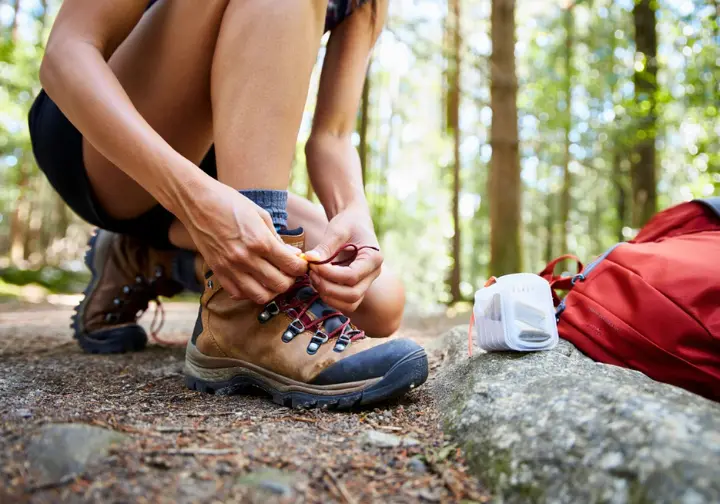
No amount of technology can save you from a poorly fitting boot. This is where your personal experience and diligence pay the biggest dividends. This section covers the essential process of finding your perfect fit, solving common issues, and caring for your boots to ensure they last for many trail miles.
The Golden Rules for a Flawless Fit
Finding the right fit is a non-negotiable process that prevents foot pain. First, always shop in the afternoon, as your feet naturally swell during the day and will be at their largest “on-trail” size. Second, bring the exact socks you’ll be hiking in; specialized hiking socks are essential for trail comfort and their thickness dramatically affects the fit of your shoes. Before lacing up, slide your foot forward and check for one finger’s width of space behind your heel. This prevents your toes from smashing into the front on descents during a long hike. Once laced, your heel should lift only minimally, if at all, to prevent blisters. Finally, simulate trail conditions in the store. Walk on any incline ramps available to test for toe bang and heel lift, revealing potential fit issues before you buy your new boots online or in person.
The Specialized Fit Clinic: Solutions for Every Foot
Every foot is different, but there’s a boot for nearly every shape, from trail runners to a full hiking boot. For wide feet, brands like KEEN are famous for their roomy toe box. A common hack is trying the men’s version of a boot, as a men’s standard width is wider than a women’s. For narrow feet, European brands like La Sportiva and SCARPA often provide a more precise, secure fit. Hikers with flat feet need stability to counter overpronation, so look for boots with a firm midsole, a feature common in Oboz footwear. For any of these issues, the boot is only half the solution. Upgrading to an aftermarket insole from a brand like Superfeet is one of the most effective upgrades you can make, creating a complete support system and helping you find options like hiking boots with wide toe narrow heel designs. This is a crucial step in choosing hiking shoes with roomy toe boxes to prevent painful issues.
Trailside First Aid and Long-Term Care
Proper care begins with a smart break-in period before any big trip. Wear new boots indoors, then on short walks around your neighborhood, before tackling a real trail. This allows the boot to mold to your foot. Never use “hacks” like soaking or heating them, as this can destroy adhesives and materials. Keep your good boots clean to maintain performance and breathability, especially after muddy hikes. When water no longer beads up, it’s time to re-apply a DWR treatment. Always air dry your boots slowly, away from direct heat like a campfire. On the trail, friction is the enemy. The moment you feel a hotspot, stop and apply moleskin. This preventative step, along with quality socks and proper lacing, is part of your trailside First Aid, Repair Kit & Tools. Finally, remember that your body is part of the system; strengthening your feet, ankles, and glutes can help prevent many of the most common hiking injuries.
The 2025 Field Report: Top Boots for Every Mission
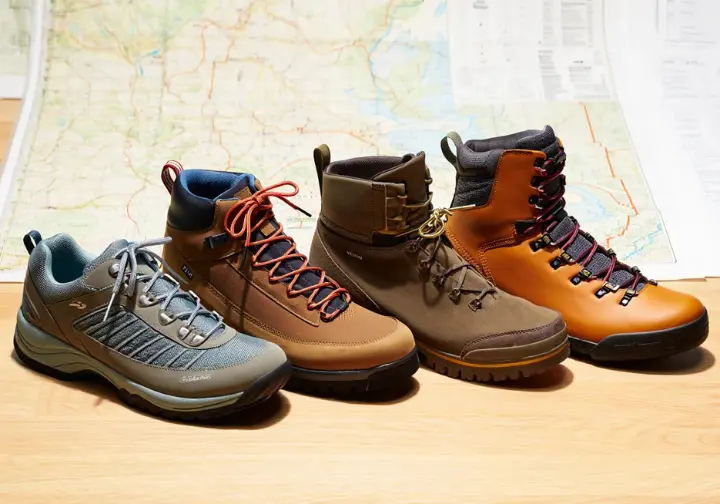
After synthesizing dozens of expert reviews from many an outdoor guide and real-world tests, we’ve identified the top-performing boots of the year. Our recommendations are categorized by their primary strengths to help you find the perfect match for your hiking style, whether for Great Lakes hikes or treks in the woods.
Best All-Around Performers
Salomon X Ultra 5 Mid GTX | The benchmark for lightweight performance and all-around trail agility
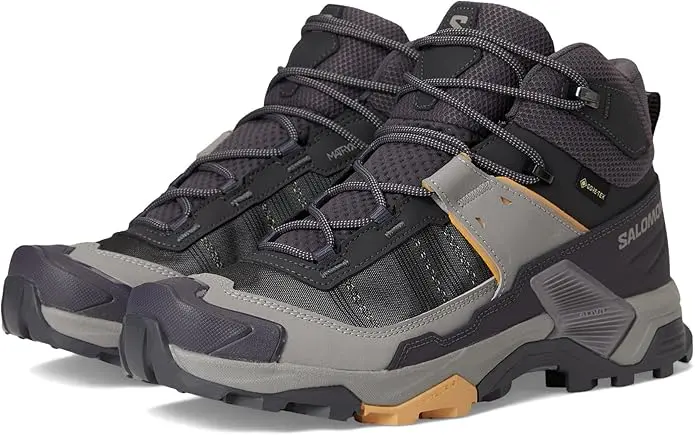
The Salomon X Ultra 5 sets the standard for hikers who want the agility of a trail runner with the support of a boot. It’s exceptionally lightweight, making long miles feel easier, but the updated Advanced Chassis™ provides serious lateral stability on technical terrain. The All Terrain Contagrip® outsole delivers best-in-class traction that inspires confidence on everything from wet rock to a well-worn trail. The primary drawback noted by some users is a slightly narrower toe box, so trying them on is a good idea. For the hiker who values speed and reliable waterproof protection without bulk, the X Ultra 5 is one of the most functional hiking shoes available.
PROS
- Incredible grip on nearly all surfaces.
- Lightweight and agile for fast hiking.
- New upper greatly improves durability.
CONS
- Toe box can feel tight and narrow.
- Runs hot in very warm climates.
- Laces may require double-knotting.
Lowa Renegade GTX Mid | Iconic durability and uncompromising support for serious backpackers
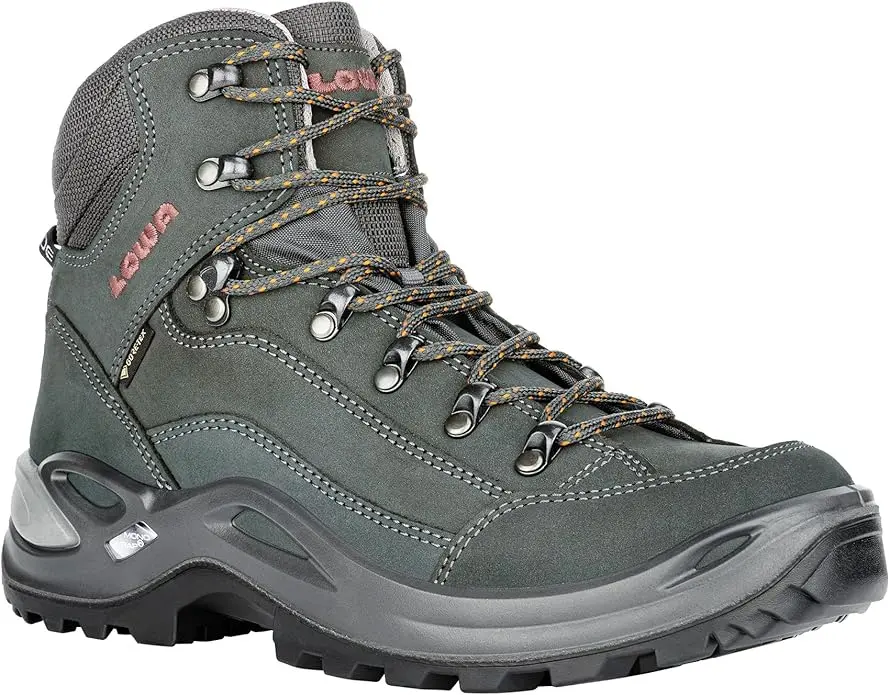
The Lowa Renegade is a legend in the hiking world for good reason. This ladies waterproof hiking boot is celebrated for its incredible out-of-the-box comfort, requiring virtually no break-in period. The nubuck leather upper and GORE-TEX liner provide robust weather protection, while the MONOWRAP® frame offers the stability needed for backpacking. Its primary strength is being a reliable, do-it-all workhorse. While heavier than some hiking boot options, its blend of comfort, support, and durability makes it a top-tier investment for serious day hikers and weekend backpackers.
PROS
- Comfortable right out of the box.
- Excellent ankle support and stability.
- Very durable, long-lasting construction.
CONS
- Sole can feel overly stiff or firm.
- Heavier than modern synthetic boots.
- Takes a long time to dry if soaked.
Merrell Moab 3 Mid WP | Unbeatable out-of-the-box comfort and value for beginners and casual hikers
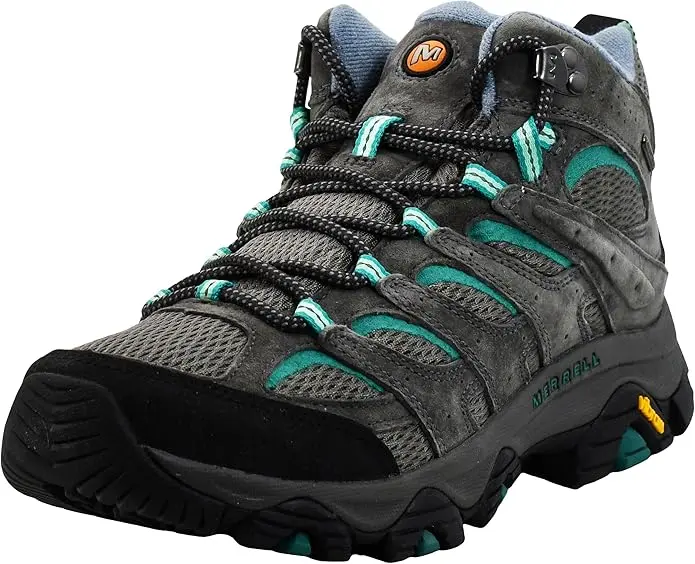
The Merrell Moab is often called the “Mother Of All Boots” for its famous out-of-the-box comfort and approachable price point, making it a gateway boot for countless hikers. It features a generous fit and reliable traction from its Vibram® outsole, making it a dependable choice for casual hikes. However, its biggest weakness is inconsistent waterproofing; a significant number of users report leaks. It can also run hot in warm weather. For day hikers or those who primarily stick to well-worn trails in dry conditions, the Moab 3 is a good hiking shoe that offers unbeatable comfort and value.
PROS
- Famous for out-of-the-box comfort.
- Excellent performance for the price.
- Good traction on various trail surfaces.
CONS
- Waterproofing is not always reliable.
- Lacks breathability in warm weather.
- Arch support feels off for some users.
La Sportiva Nucleo High II GTX | A lightweight powerhouse with exceptional breathability and a precise fit
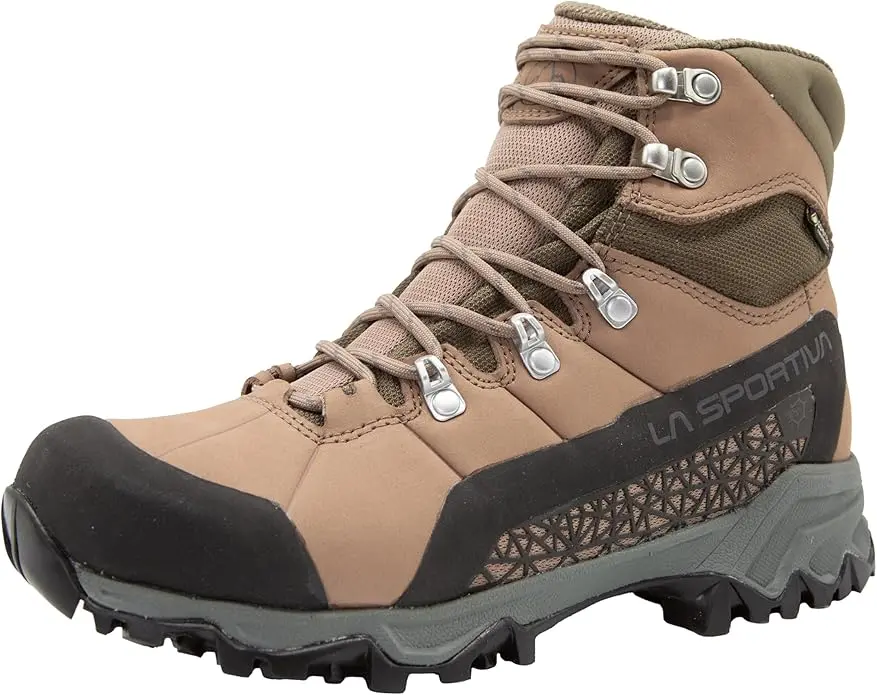
The Nucleo High II solves a common problem with waterproof boots: breathability. Thanks to its GORE-TEX® SURROUND® technology, it’s one of the best-ventilated waterproof boots on the market, perfect for a top-notch hiking experience. It combines this with a lightweight, agile feel, excellent ankle support, and sticky traction on rock. The fit is precise and athletic. The main concern is durability in specific areas; some users report premature wear on the mesh panels. For hikers in warmer climates who still need waterproof protection and value a nimble, precise fit, the exceptional breathability of the Nucleo High II is a game-changer.
PROS
- Best-in-class breathability for a WP boot.
- Lightweight feel with great ankle support.
- Excellent traction, especially on rock.
CONS
- Mesh areas can wear out prematurely.
- Standard fit runs narrow for many.
- Premium price point is very high.
Best for Specific Needs: Cushioning, Support, and Fit
Hoka Anacapa 2 Mid GTX | The ultimate choice for maximalist cushioning and long-distance comfort
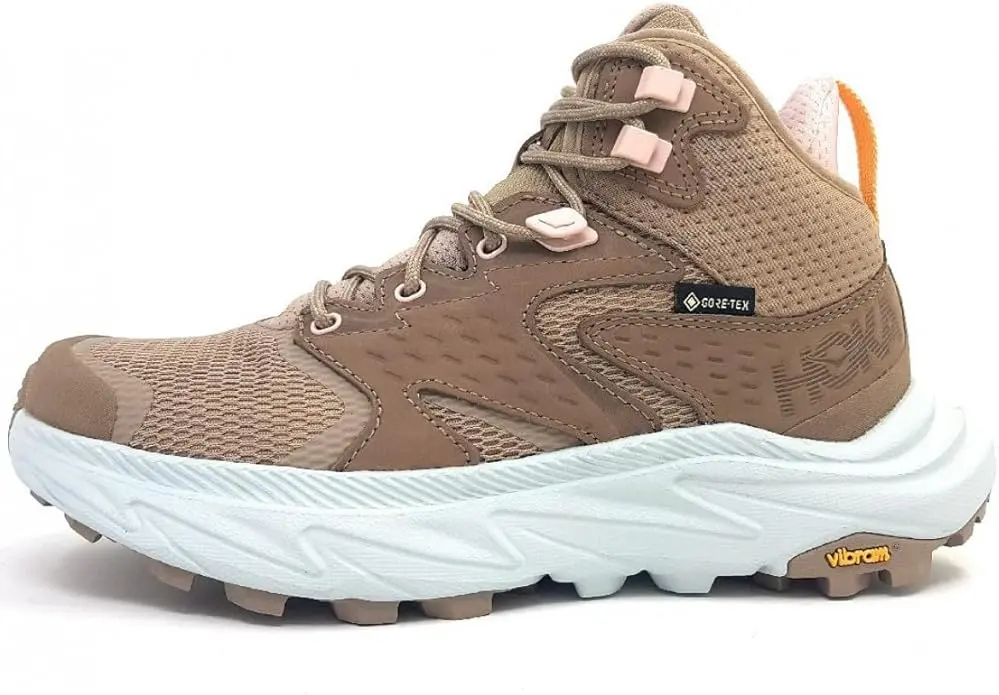
Hoka brought its signature maximalist cushioning from its runners to hiking, and the Anacapa 2 is a dream for those who prioritize plush comfort over long distances. The thick EVA midsole absorbs incredible amounts of impact, reducing foot fatigue for thru-hikers. This is paired with a Vibram® Megagrip outsole for excellent traction. The design is undeniably bulky. But for backpackers, or any hiker with sensitive feet, the cloud-like ride and joint-saving cushioning of the Anacapa 2 are simply unmatched for hiker-performance.
PROS
- Maximum cushioning for ultimate comfort.
- Excellent traction with Vibram Megagrip.
- Reliable GORE-TEX waterproofing.
CONS
- Feels bulky compared to other boots.
- Lacing system can be hard to tighten.
- Extended heel can catch on rocks.
Salomon Quest 4 GTX | Expedition-grade stability and ankle support for heavy backpacking
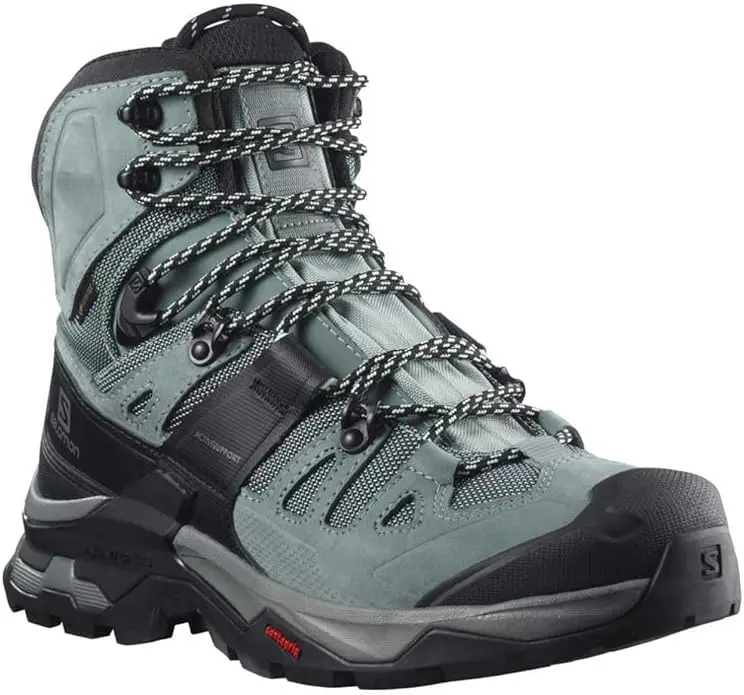
When the trail gets rough and the pack gets heavy, the Salomon Quest 4 is the boot you want. Its defining feature is its ADV-C 4D Chassis, which provides fortress-like stability, making it ideal for colder hikes or rugged terrain. The high, padded collar and secure lacing system lock your foot in place. This level of support comes with a trade-off in weight and stiffness, and it requires a break-in period. For serious backpackers carrying heavy loads, or women tackling a route like the Superior Hiking Trail, the Quest 4’s uncompromising stability is an essential safety feature.
PROS
- Unmatched stability for heavy packs.
- Outstanding ankle support on rough terrain.
- Aggressive traction on all surfaces.
CONS
- Stiff and requires a break-in period.
- Heavy and bulky for some hikers.
- Ankle stiffener can cause discomfort.
KEEN Targhee IV | The go-to choice for wide-footed hikers needing a roomy toe box
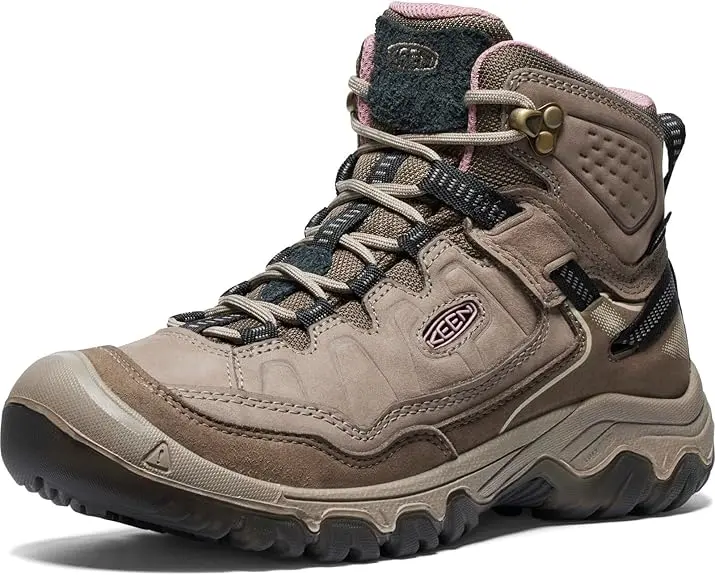
KEEN built its reputation on a comfortable, roomy fit, and the Targhee IV continues that legacy. It’s the ideal choice for women with wide feet or those who simply want ample space for their toes to splay. The standout feature is the KEEN.FUSION construction, a glue-free bond that is guaranteed not to delaminate. It offers solid waterproofing and great traction. Many Oboz women’s models also offer a great fit, but the Targhee is iconic. While it lacks the precision of a narrower boot, its combination of a generous fit and enhanced durability makes it a fantastic, reliable workhorse.
PROS
- Glue-free build won’t delaminate.
- Roomy toe box is great for wide feet.
- Superb traction on varied terrain.
CONS
- Lacks breathability on very warm hikes.
- Too wide for those with narrow feet.
- Stock insole may lack arch support.
Altra Lone Peak Hiker 2 | A zero-drop option with an anatomical fit for natural foot splay
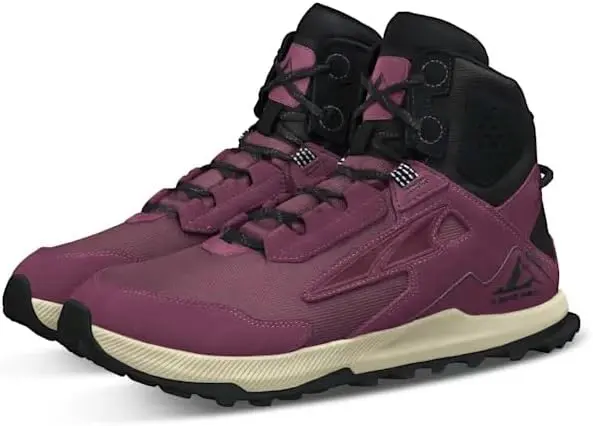
The Altra Lone Peak Hiker 2 is built for those who prefer a natural foot position, somewhat like minimalist Bedrocks sandals but with full protection. It features Altra’s signature FootShape™ toe box and a zero-drop platform. This promotes a natural stride and is incredibly comfortable for many. The boot is also remarkably lightweight. The main downsides are durability concerns and a lacing system that can be difficult to secure for steep descents. For hikers already accustomed to zero-drop footwear who prioritize lightweight comfort, this is an excellent choice for many types of outdoor hikes.
PROS
- Very comfortable with a wide toe box.
- Incredibly lightweight and nimble feel.
- Zero-drop promotes a natural stride.
CONS
- Lacing system is hard to get snug.
- Upper and sole have durability issues.
- Zero-drop requires an adjustment period.
Final Verdict: Choosing Your Next Adventure Partner
The “best” hiking boot is a personal choice, defined by the unique intersection of your feet, your budget, and your hiking ambitions. By understanding boot anatomy, material trade-offs, and the principles of a proper fit, you are empowered to make a decision based on performance. The Salomon X Ultra 5 Mid GTX offers unbeatable versatility. For maximum durability on long hikes, an investment in the Lowa Renegade GTX Mid or Salomon Quest 4 GTX provides essential stability. For comfort and value, the Merrell Moab 3 Mid remains a trusted workhorse. Above all, remember the golden rule: no amount of technology can fix a poor fit, so prioritize finding the right shape for your foot.
Frequently Asked Questions about Women’s Hiking Boots
Are waterproof (GORE-TEX) boots always the better choice? +
How long should a good pair of hiking boots last? +
Do I really need to break in modern hiking boots? +
What is the single most important factor when choosing a hiking boot? +
We are a participant in the Amazon Services LLC Associates Program, an affiliate advertising program designed to provide a means for sites to earn advertising fees by advertising and linking to Amazon.com. As an Amazon Associate I earn from qualifying purchases. We also participate in other affiliate programs. The information provided on this website is provided for entertainment purposes only. We make no representations or warranties of any kind, expressed or implied, about the completeness, accuracy, adequacy, legality, usefulness, reliability, suitability, or availability of the information, or about anything else. Any reliance you place on the information is therefore strictly at your own risk. Additional terms are found in the terms of service.









![Trek Budgeting: A Data-Backed Guide [+ Free Template] A trekker sits at a desk planning a trip budget on a laptop, with a stunning view of the Himalayan mountains visible through a window behind them.](https://thehikingtribe.com/wp-content/uploads/2025/07/00-trek-budgeting-data-backed-planning-100x75.webp)

